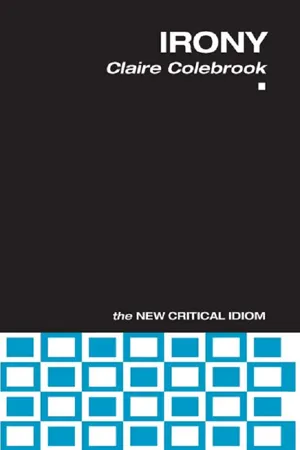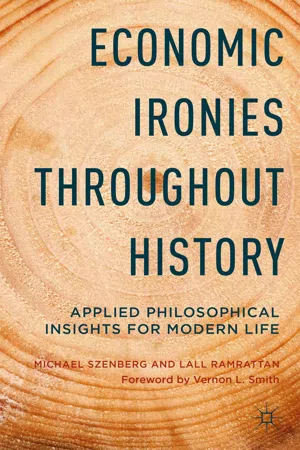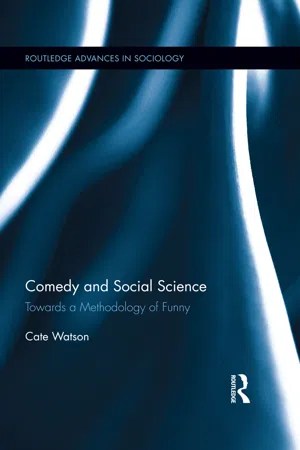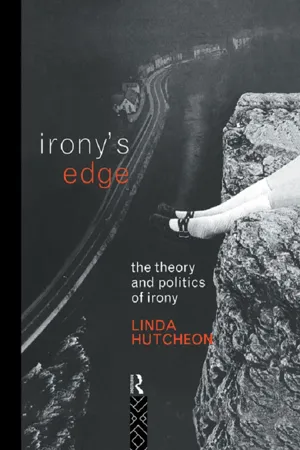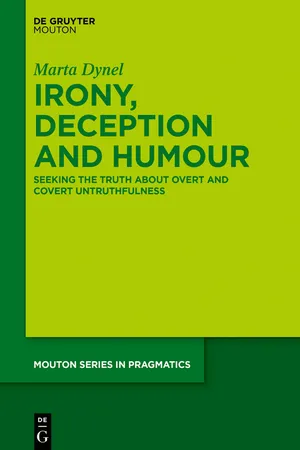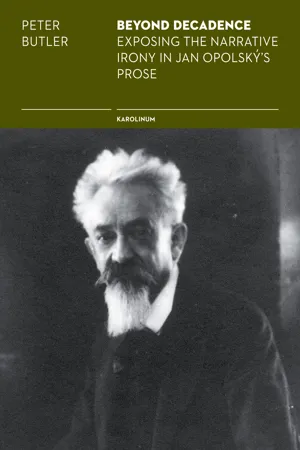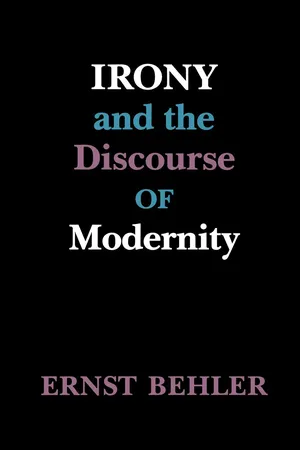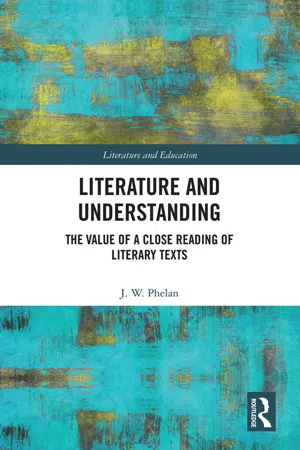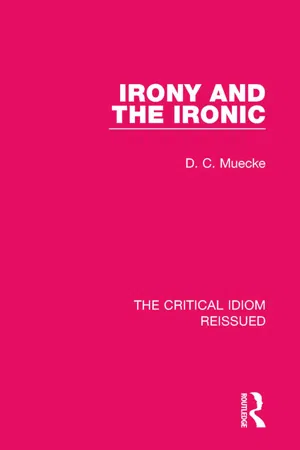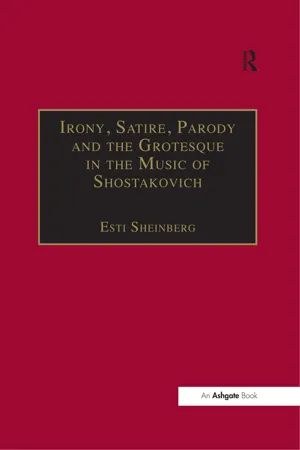Literature
Irony
Irony in literature refers to a contrast between what is expected and what actually occurs. It can manifest in various forms, such as verbal irony, situational irony, and dramatic irony. Verbal irony involves saying one thing but meaning another, while situational irony occurs when the outcome is different from what was anticipated. Dramatic irony arises when the audience knows something that the characters do not.
Written by Perlego with AI-assistance
Related key terms
11 Key excerpts on "Irony"
- really mean . This can be simple. If I say, ‘This is paradise!’ and our context – the weather outside – is clearly not blissful, then you know I am being ironic. But what happens in literature where, precisely because texts circulate from other contexts, we have no obvious context to refer to? Irony therefore raises the question of literary interpretation: if we know what a word means according to its context, how do we know or secure a proper context?Shakespearean drama, for example, was once read and received as a sincere defence and representation of the well-ordered, pre-modern cosmos (Bradley 1905). Such a reading was possible only because of a (then) widely shared notion about historical context: the Elizabethan world-view was one of unquestioning belief and obedience to ordained law (Lovejoy 1936). Today, however, Shakespeare is often read ironically: not as a writer who represented the standard world-view, but as a dramatist who displayed and invented that world-view as a position to be questioned (Dollimore and Sinfield 1985; Drakakis 1995). Such new readings are possible because critics have recreated the supposedly original context. According to the new historicist criticism that was dominant in the 1980s, contexts are not passive backgrounds to the texts we read; contexts are created by texts, with each text also presenting the instabilities and insecurities of context. A text is never just what it says; it also displays the production and force of different ways of speaking. According to Stephen Greenblatt, the Renaissance was an era of competing and contested representations (Greenblatt 1988). Texts were anything but sincere; they presented standard Elizabethan myths of power as myths. The very practice of re-reading the past and of suspecting that all those texts that were once read as sincere might actually be critical of the power they describe depends upon the structure of Irony. It is always possible, particularly if we question or re-invent a context, that a text can be read as having a meaning other than what it says. The twentieth-century writer Jorge Luis Borges gives a stunning example of how even the most sacred texts can be exposed to Irony. In ‘Pierre Menard, Author of Don Quixote’, Borges describes the project of a twentieth-century author who sets himself the task of rewriting Miguel de Cervantes’ Don Quixote . Simply transcribing the novel would be too facile a task, so Pierre Menard decides to project himself into the position of the original Cervantes. Eventually, he produces one identical paragraph of the ‘original’ text. Of course this completely identical paragraph is stunningly ironic, for the very circumstance of its new context gives it an entirely transformed sense. Borges then suggests that all the texts of Western culture could benefit from this imaginative device. What if we were to imagine The Imitation of Christ
- eBook - ePub
Economic Ironies Throughout History
Applied Philosophical Insights for Modern Life
- Michael Szenberg, L. Ramrattan(Authors)
- 2014(Publication Date)
- Palgrave Macmillan(Publisher)
As a working definition, we take Irony to mean a pretense, ignorance, or falseness. Irony refers to many ideas—verbal Irony, dramatic Irony, situational Irony, Irony of fate, Irony of satire, and Socratic Irony. Verbal ironies are common in speech, such as when we say one thing but mean the opposite—for example, saying it is a nice day when it is actually raining heavily. Situational Irony is also well known, such as in the saying that someone “killed the goose that laid the golden eggs.” We mention dramatic ironies as used in Sophocles’ Oedipus Rex and in Shakespeare’s dramas. To further underscore the significance of Irony, Goethe, a German literary authority, spoke of “artful Irony designed to please us,” “good willed Irony with their justness,” “broadness of view,” “gentleness in adversity and constancy in changes,” and “narrative Irony,” affirming that truth can be known only through its “manifold manifestation and reflections” (Goethe 1995, Vol. 3, 184, 256; Vol. 10, 9). Booth, a modern rhetorician, gives us definitions of Irony that are overt (stable and local or finite) and covert (unstable and infinite) (Booth 1974, 235). Philosophers use Irony as a path to the truth. Two philosophers, Ludwig Wittgenstein and Ferdinand Saussure, working independently, have asserted that language holds the key to explaining the world. Language uses words, while thought uses ideas. Ideas represent objects, which can be used in relationships to form propositions which we can study for their truth or fal sity (Harris 1996, 2). We use language to communicate thoughts to others. Keep in mind that language may fail us. We find gaps between the expression and the ideas expressed and between ideas and facts (5). While Saussure is willing to separate linguistic from non-linguistic social phenomena, Wittgenstein bases language on social language games (113) - eBook - ePub
Comedy and Social Science
Towards a Methodology of Funny
- Cate Watson(Author)
- 2015(Publication Date)
- Routledge(Publisher)
3 Irony and the Ironic Imagination DOI: 10.4324/9781315731407-3INTRODUCTION
While Irony is a difficult term to define, with many variants, the most common definition, according to Colebrook (2004 , p. 1), is ‘saying something contrary to what is meant’. Though she regards this as simplistic almost to the point of uselessness, it immediately throws up problems for the social scientist who has, generally speaking, undergone an extensive training aimed at avoiding exactly that sort of thing. Irony, as a rhetorical trope which exerts its effects through juxtaposition and the creation of incongruity, constitutes a potential analytical tool in social research, overturning expectations and operating within a logic of discovery. Irony is ‘a metaphor of opposites, a seeing of something from the viewpoint of its antithesis’ (Brown, 1989 , p. 174), and it is the ability to do this which constitutes the art of social science. Indeed, Brown contends that ‘the prime instrument of sociological knowledge is an eye for paradox, contradiction and reversals that are latent beneath the more obvious manifest content of action’ (p. 178). He goes on, ‘[T]he sociologist must “estrange” taken-for-granted reality so that it appears in a new and previously unsuspected light; he must be the man who shouts “Theatre!” in the middle of a crowded fire’ (p. 183).Brown sets out four major forms of ironic expression: rhetorical Irony, Irony of manner, Irony of events and dramatic or dialectical Irony. Rhetorical Irony is essentially Colebrook’s definition, saying something contrary to what is meant (though there must in some sense be a reversal of meaning; otherwise this would be simply lying). The ‘sweetest’ form of this, Brown says, is when the ironist takes the opponent’s argument and defends it to the point of absurdity (an extended example of this is included in Chapter Four ). Irony of manner and Irony of events concern actions. In Irony of manner an ambiguous act is performed, the meaning of which is known only to the audience whilst the ‘target’ remains in ignorance. Brown provides the intriguing example ‘as when “Agnes” convinced Harold Garfinkel that he had always been a girl’ (1989, p.175). (Shocked at this, I hurried to the source, only to find, disappointingly, that the pronoun ‘he’ referred not to the celebrated ethnomethodologist Harold Garfinkel but to his transsexual research participant). Irony of events relates to the larger historical canvas and the undermining of man’s intentions by the fates, gods and so on. The fourth type, dramatic or dialectical Irony, is the ‘master trope’ which subsumes but in important ways transcends the other three forms. Most notably, dramatic Irony is structural and therefore provokes insights revealing logical contradictions which lead us towards a closer examination of our paradigmatic presuppositions. This is at the heart of what Louis Schneider (1971) calls a dialectical ‘bent’ or ‘bias’ which characterizes sociological thought and which has yielded some of its most fundamental insights. While Schneider accepts that there is no usable dialectical method as such, there is nonetheless a world view which ‘emphasizes development through conflict, the moving power of human passions which produce wholly unintended results, and the Irony of sudden reversals’ (p. 668)—a list which reads like the standard plot summary of any baroque drama. Of particular note here is the unintended or unanticipated consequence which amounts almost to an Irony inherent in the human condition. Schneider (p. 670n) goes so far as to say that ‘it has actually been argued by some’ (though he does not specify whom) ‘that the phenomenon is the - eBook - ePub
Irony's Edge
The Theory and Politics of Irony
- Linda Hutcheon(Author)
- 2003(Publication Date)
- Routledge(Publisher)
And it happens in discourse, in usage, in the dynamic space of the interaction of text, context, and interpreter (and, sometimes, though not always, intending ironist). As a response to the extensive literature—in many different fields, from linguistics to psychology, from rhetoric to literary criticism—that sees Irony as a straightforward semantic inversion (antiphrasis—or saying one thing and meaning its opposite) and thus as a static rhetorical tool to be used, this chapter expands on the suggestion made earlier in this book that Irony is, instead, a communicative process. It is in this framework, then, that I would argue that ironic meaning possesses three major semantic characteristics: it is relational, inclusive and differential. Irony is a relational strategy in the sense that it operates not only between meanings (said, unsaid) but between people (ironists, interpreters, targets). Ironic meaning comes into being as the consequence of a relationship, a dynamic, performative bringing together of different meaning-makers, but also of different meanings, first, in order to create something new and, then, as Chapter 2 explored, to endow it with the critical edge of judgment. As noted, that Greek eiron, from whom Irony got its name, was a dissembler, a pretender, and that notion of pretense figures frequently in “performative” theories of Irony (Koestler 1964: 73–4; and especially Clark and Gerrig 1984: 121), humor (Douglas 1975), and figurative language, in general. In fact, it seems that children have to learn about pretense in order to understand Irony (Winner 1988). The social dimension of this relational aspect of Irony is the subject of the next chapter on discursive communities and their role in the enabling and comprehending of Irony - eBook - ePub
- Marta Dynel(Author)
- 2018(Publication Date)
- De Gruyter Mouton(Publisher)
Irony is conceptualised as a figure displaying overt untruthfulness (consequent upon the flouting of the first maxim of Quality) and meaning opposition, which invites evaluative implicature concerning a referent, based on some form of meaning reversal. Irony, it is argued, necessarily implicates (and is motivated by) the speaker’s negative evaluation of an ironic referent. The theoretical stages of meaning derivation are dissected and five salient types of Irony are distinguished through the lens of untruthfulness, based on the forms of meaning opposition and meaning reversal involved. Additionally, further manifestations of Irony are discussed in the context of its co-occurrence with the other Quality-based figures (metaphor, meiosis and hyperbole). This complex pragmatic-philosophical account is enriched by a description of the (interactional) pragmatic workings of Irony. A distinction is made between the target of and a listener to Irony. Some explanation is also offered as to why criticism may be mitigated or exacerbated through the use of Irony, thereby accounting for the contradictory findings reported by empirical/experimental research. Consequently, the perennial problem of distinguishing sarcasm from Irony is addressed, and the notion of sarcastic Irony (Irony aimed at a disparaged target) is endorsed with regard to a combination of the two constructs. 1 Approaching the figure of Irony “Irony” tends to be used as an umbrella term for a number of distinct phenomena: Socratic Irony, dramatic Irony, Irony of fate, situational Irony, and – last but not least – a trope, also referred to as a (rhetorical/stylistic) figure (see e.g. Fowler 1965; Beckson and Ganz 1989; Haverkate 1990; Kreuz and Roberts 1993; Simpson 2011; Dynel 2014, 2017c). Some attempts have been made to account for more than one species of Irony simultaneously, given their similarities - eBook - ePub
Beyond Decadence
Exposing the Narrative Irony in Jan Opolský's Prose
- Peter Butler(Author)
- 2015(Publication Date)
- Karolinum Press, Charles University(Publisher)
Second, since literary scholarship is often in the service of literary history, putting works in (a literary, historical, social, biographical) context is of paramount importance. With narrative Irony, preoccupation with context can obscure the message. Narrative Irony requires us to focus on the structure of an individual text and the only context it requires is normally provided by the sort of knowledge accessible to any educated reader of the time. This will include some information about the author, but only enough to be able to answer questions of a rather basic kind like: ‘Could the author have seriously intended a ‘straight’ reading?’, ‘Could what appears to be Irony be due to nothing more than poor style?’, ‘Was the writer of sound mind?’. 155 Third, verbal Irony is understood with reference to a standard of ‘normality’ (conventional usage/common sense/shared knowledge, values and expectations) against which the surface meaning is found wanting. It is the resulting disparity that leads the listener/reader to reconstruct an alternative reading more in line with the implicit standard. This is as true of simple conversational ironies as it is of sophisticated literary ironies. Literary scholars, knowing from extensive experience that almost anything is possible in a literary text and that a writer’s expression often reflects not only the conventions of his period but also the idiosyncracies of his individual poetic vision, can easily feel that to compare what a text says with a standard of ‘normality’ is intolerably naïve. 4.7.2 CHALLENGES TO EXPOSITION We all know that you can kill a joke by explaining it, and the same is true of Irony. With a joke, we are meant to ‘get it’ and a significant part of what makes a joke funny depends on that moment of realization when we do finally ‘get it’, and do so alone and unaided - eBook - ePub
- Ernst Behler(Author)
- 2014(Publication Date)
- University of Washington Press(Publisher)
3Irony in the Ancient and the Modern World
Irony is inseparable from the evolution of the modern consciousness. In one respect, Irony is a traditional subject, as old as human speech, codified in manuals, defined in its structure, but as unexciting as these scholastic topics are. In another regard, however, Irony is virtually identical with that self-reflective style of poetry that became accentuated during the romantic age, and it is a decisive mark of literary modernity. In a move typical of romantic thought, however, Irony was then turned around and discovered in works of literature where it had never before been surmised and thus became almost coextensive with literature itself. There is general agreement that this decisive extension of Irony to a basic critical term took place toward the end of the eighteenth century and coincided with the formation of the romantic theory of literature. Until then, Irony had been understood mostly as a figure of speech, firmly established and registered in rhetoric. We can even specify this turning point much more precisely by referring to a fragment written in 1797 by Friedrich Schlegel and expressing, to all appearances, the new feature of Irony for the first time.The fragment begins with the statement, “Philosophy is the true homeland of Irony, which one would like to define as logical beauty” (FS , 2:152, no. 42; LF , 148)1 —obviously referring to Socratic Irony as the first manifestation of the ironic mood in the West. Schlegel goes on to say that there is also a “rhetorical species of Irony,” which “sparingly used, has an excellent effect, especially in polemics” (FS , 2:152, no. 42; LF , 148). This phrase of the fragment apparently relates to the dominant usage of Irony from Cicero to Swift and Voltaire as a rhetorical device or figure of speech that is good in polemics because it attacks indirectly and not in a vulgar way. Yet compared to the philosophical type of Irony, to the “sublime urbanity of the Socratic muse,” this rhetorical kind is more pompous. There is one possibility, however, of approaching and equaling the lofty Socratic style of Irony, and that is in poetry. For this purpose, however, poetry should not restrict Irony to “isolated ironical passages, as rhetoric does,” but be ironic throughout, as Socrates was in his dialogues. As a matter of fact, Schlegel continues, there is a poetry that accomplishes precisely this task: “There are ancient and modern poems that are pervaded by the divine breath of Irony throughout and informed by a truly transcendental buffoonery. Internally: the mood that surveys everything and rises infinitely above all limitations, even above its own art, virtue, or genius; externally, in its execution: the mimic style of a moderately gifted Italian buffo ” (FS , 2:152, no. 42; LF - eBook - ePub
Literature and Understanding
The Value of a Close Reading of Literary Texts
- Jon Phelan(Author)
- 2020(Publication Date)
- Routledge(Publisher)
how the reader gains cognitive benefit from reading literary fiction. The chapter ends with two further comments on the aesthetic and moral implications of the preceding argument.Irony‘Being ironic’ belongs with the multiplicity of language games identified by Wittgenstein in his Philosophical Investigations (I. 23) alongside ‘making up a story’, ‘play-acting’ or ‘guessing riddles’. One of the earliest mentions of Eirōneia occurs in Aristotle’s Nicomachean Ethics where Irony involves playful understatement. ‘Irony’ is cited as the deficiency where truthfulness is the mean and boastfulness is the excess (II. 7. 1108a19–22). The magnanimous person is characterised as someone who is candid and straight-speaking except when public occasions demand a degree of self-deprecation or ‘Irony’ (IV. 3. 1124b30; IV. 7. 1127a22f). In this case, virtuous individuals are permitted to use Irony in order to win over an audience; appearing not to take themselves too seriously.A single, unified account of Irony proves problematic given the scope of what is deemed ironic and I agree with Peter Goldie’s comments, in his review of Gregory Currie’s ‘pretence account’ of Irony:One notable thing about Irony is its multiple forms and uses, and the multiple ways in which Irony is bound up with other kinds of trope and rhetorical device – litotes, bathos, hyperbole, metaphor, sarcasm, and many others. … As Currie himself accepts, ‘Irony can become very complex’ (158). Perhaps in the end trying to provide a theory of Irony, whether the pretence theory or any other kind of theory, is as dangerous as trying to provide a theory of humour.(Goldie 2011: 336)Allusion is an example of another literary device that can be ironic: ‘Most allusions serve to illustrate or clarify or enhance a subject, but some are used in order to undercut it ironically by the discrepancy between the subject and the allusion’ (Abrams 1993: 8). Allusion deserves separate comment at the end of this section. - eBook - ePub
- D. C. Muecke(Author)
- 2017(Publication Date)
- Routledge(Publisher)
There is a second and stronger sense in which we can say that drama, though not necessarily ironic, is typically so. Just as the ironic observer of a situational Irony sees the victim behaving in confident unawareness of the real state of affairs, so, in most plays, the audience will know more of what is going on than the dramatis personae. In many plays the audience will already know what the outcome will be from the prologue or the programme notes or the title or previous performances or from earlier versions in literature or legend or from history. Consequently it will see the dramatis personae possessed by mistaken or unnecessary hopes, fears, convictions, etc. Even in plays about which the audience has no advance knowledge, it will generally soon know more than the dramatis personae since the audience is always present, but the dramatis personae see and hear at most only what takes places when they are on the stage.I have suggested that Irony is essentially both theatrical and dramatic though in some respects only in a weak sense. I have suggested, too, that drama is at least typically ironic and perhaps essentially ironigenic, that is, productive of Irony; Kenneth Burke more or less ‘equates’ drama, dialectic, Irony and peripeteia (A Grammar of Motives, Cleveland and New York, 1962, pp. 503–17), and it is not easy to think of a play from Aeschylus to Arrabal in which there is no ironic structure or no ironic situations or events. But now I want to move into a more speculative area with the hypothesis that the nature of drama is such that plays tend to be ironical as a result of internalizing one or more elements of their immediate theatrical environment or context, that is, the necessary pre-conditions and material supports of the plays themselves as listed at the beginning of this section.Internalization is not something found only in plays. There is the song that conventionally internalizes the singer: - eBook - ePub
- Lee Konstantinou(Author)
- 2016(Publication Date)
- Harvard University Press(Publisher)
41 Such ironies all posit a relatively unified subject (whether speaker or listener) capable of recognizing the disjunction between what is said and what is meant, between the typical workings of this or that system of tropes and the manipulation of the system, between one frame of reference and another, between direct and indirect communication.But perhaps the politics of Irony does not finally reside in some subject’s awareness of the disjunction between different levels of meaning. The tradition of Irony that has followed from German Romanticism suggests a different model of the political significance of Irony, one not easily assimilated to contemporary cognitive approaches.42 Perhaps the politics of Irony inheres not in its epistemological complexity, or even in our inability to settle on a final interpretation of unstable ironies, but rather in Irony’s power to disrupt our capacity to parse statements. Irony exhausts, blocks, or undermines the reasoning mind, breaking down the process through which subject formation and the subject’s effort to apprehend the world happen in the first place. Irony defeats our capacity to make sense of our environment because it is, as Friedrich Schlegel famously put it, “a permanent parabasis.”43 Parabasis was the moment in Attic Comedy when the chorus interrupted the play’s action to insult the audience. In another fragment, Schlegel calls Irony “the clear consciousness of eternal agility, of an infinitely teeming chaos.”44 Irony as “permanent parabasis” or “eternal agility” promises to intermit all philosophical, critical, aesthetic, and political foundations. Hegel complained that Romantic Irony made the subject all powerful, giving subjectivity a “God-like geniality,” but others have associated Schlegel’s “permanent parabasis” with “unrelenting antifoundationalist skepticism.”45 In the view of some contemporary critics, antifoundational Irony becomes political precisely because it “severs the continuity essential to the very logic of making sense.”46 It is, Lee Edelman suggests, “the queerest of rhetorical devices.”47 In their strong form, such claims about the politics of Irony seem to me to be no more tenable than cognitive models. As Christian Thorne explains in The Dialectic of Counter-Enlightenment, the thesis that one’s views on the foundations of knowledge have any necessary political implications is “an epistemological determinism fully as egregious as the economic or technological determinisms that have preceded it.”48 Thorne demonstrates that “anti-foundationalism is not everywhere the same,” mounting his persuasive brief via a number of case studies in the long history of anti-Enlightenment thought.49 Much the same objection could be leveled against arguments that take Irony’s alleged antifoundationalism as politically determinative. The problem is not, as Hegel argues, that “[t]he ironical . . . consists in the self-annihilation of what is noble, great, and excellent.”50 - eBook - ePub
Irony, Satire, Parody and the Grotesque in the Music of Shostakovich
A Theory of Musical Incongruities
- Esti Sheinberg(Author)
- 2017(Publication Date)
- Routledge(Publisher)
Part II IronyPassage contains an image
Chapter One The concept of Irony: philosophical backgroundFrom its very beginning as an independent concept in the Platonic writings and throughout history, Irony was doubly conceived, either as a rhetorical device for the communication of definitive meanings or as an independent phenomenon, a mode of perceiving reality, that exists in and of itself. Most of the theoretical treatises on the concept of Irony have their roots in the nineteenth century, particularly in the philosophical writings of Friedrich Schlegel (1772-1829) and Søren Kierkegaard (1813-55). Their ideas, however, developed from quite different vantage points, neither of them purely philosophical: while Schlegel was a literary critic, Kierkegaard primarily considered himself a theologian. In a sense, the various meanings that contemporary thought ascribes to Irony emerge from this basic dichotomy that seems to lie at the core of Irony's immanent duality: its simultaneous existence as a means and as an end.The first methodological analysis of Irony, Søren Kierkegaard's The Concept of Irony , explicitly posed the problem of Irony's double nature. He pointed to the existence of 'duplexities' in the Platonic writings, and arrived at the conclusion that Plato had actually presented two different concepts of Irony, each of which was tightly connected with a corresponding kind of dialectic (Kierkegaard, [1841] 1989: 40, 121 ff.). This form of presentation is of major importance to the understanding of Kierkegaard's two concepts of Irony, since it connects Irony to the alienation stage of the dialectic process (i.e. the conceptual negation of the original idea). As he does with Irony, so also Kierkegaard differentiates between alienation as a device and alienation as an end in itself. The first kind of alienation is the necessary stage of antithesis in a dialectical process which strives to a synthesis, i.e. to a positive solution; the second kind is the creation of an antithesis for its own sake, as avowal of negation qua negation, inquiry qua inquiry, presenting them as an inherent phenomenon of the human mind. Although Kierkegaard regards both phenomena as manifestations of Irony, he is nevertheless conscious of the differences between them; in connecting these two kinds of dialectical process with the two corresponding kinds of Irony, he names them Irony as stimulus and Irony as terminus
Index pages curate the most relevant extracts from our library of academic textbooks. They’ve been created using an in-house natural language model (NLM), each adding context and meaning to key research topics.
